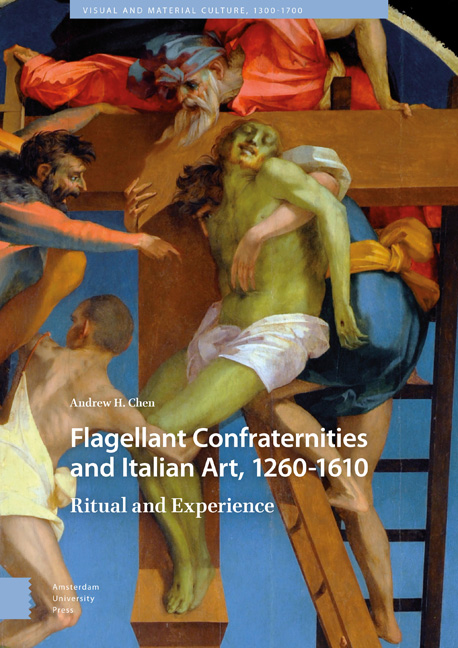Book contents
- Frontmatter
- Deduction
- Contents
- Abbreviations
- List of Illustrations
- Acknowledgements
- Introduction
- Part I Art and Ritual, to 1450
- 1 Flagellation and Its Settings
- 2 Images at Entrances, and Ascesis
- 3 Mass
- 4 Comforting
- 5 Processions
- Part II Transformations
- 6 Changes in Ritual Before Trent
- 7 Changes in imagery before Trent: Sansepolcro and Volterra
- 8 After Trent: Florence and Milan
- Epilogue: Global Flagellation
- Bibliography
- Index of Illuminated Manuscripts (by location)
- Index of Paintings (by location)
- Index of Topics
6 - Changes in Ritual Before Trent
Published online by Cambridge University Press: 11 December 2020
- Frontmatter
- Deduction
- Contents
- Abbreviations
- List of Illustrations
- Acknowledgements
- Introduction
- Part I Art and Ritual, to 1450
- 1 Flagellation and Its Settings
- 2 Images at Entrances, and Ascesis
- 3 Mass
- 4 Comforting
- 5 Processions
- Part II Transformations
- 6 Changes in Ritual Before Trent
- 7 Changes in imagery before Trent: Sansepolcro and Volterra
- 8 After Trent: Florence and Milan
- Epilogue: Global Flagellation
- Bibliography
- Index of Illuminated Manuscripts (by location)
- Index of Paintings (by location)
- Index of Topics
Summary
This chapter concerns shifting attitudes toward flagellation and the implications of changes in ritual for the interpretation of images. We have already encountered, in Chapter 1, cases where flagellation was optional, or the remit of a subgroup. In the fourteenth century, members of a Modenese confraternity who did not wish to participate in flagellation could opt out. By the end of the fourteenth century the Scuola Grande of the Misericordia in Venice was exempting nobles. In the sixteenth century, flagellation was no longer practised during private meetings of the scuole grandi; it featured in special processions as a gesture to the ‘ancient devotion’ (antica devozione) and was done only by poor members of these companies or hired men. In fifteenth-century Bologna, only a fraction of confraternity members – those who belonged to stretta cells – took the discipline.
Discontinuation of flagellation was about the most radical departure from original values that a company founded on principles of extreme austerity and penitence could effect. Such a change also meant that older images of people with whips could not be read as before. They became, instead, images of a bygone tradition, to be viewed from the other side of a historical caesura.
By the time the frontispiece of the 1562 statute book of Santa Maria della Morte, Bologna, was executed (Fig. 52), the company had made the transition. The miniature shows members of the confraternity with their tavolette beneath the mantle of the Virgin. Each panel has six narrative scenes organized in a two-by-three grid – an arrangement akin to that of the panel in Stuttgart. In the background is a scene of procession. The confratelli still wear white hoods and habits, but gone are the circular openings in the back visible in fourteenth-century images of the confraternity, and there are no whips anywhere. Flagellation is not mentioned anywhere in the text. Confraternal dress, which had been functionally and symbolically associated with the whip for so long, maintained its form, vestigially. In the later sixteenth century, Bolognese prisoners continued to benefit from the company and encouragement of the brothers of Santa Maria della Morte with their tavolette, but these confratelli could no longer be described as ‘flagellants in the crowd’ at the church of San Giovanni Decollato.
- Type
- Chapter
- Information
- Flagellant Confraternities and Italian Art, 1260–1610Ritual and Experience, pp. 153 - 161Publisher: Amsterdam University PressPrint publication year: 2018



